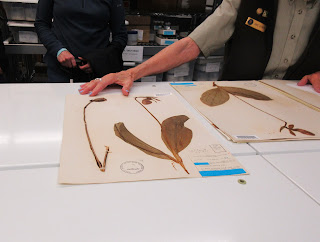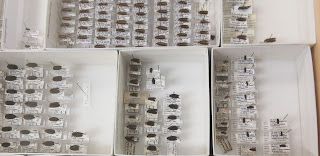Located a short drive from downtown Gatlinburg, in a rather inconspicuous location, The NPS houses many of its natural history collections in this 15,000 square foot building. Opened in 2007, I first visited a couple years later for a Wilderness First Aid course offered by the Appalachian Trail Conservancy. This visit was a brief tour of the collections and explanation the work preformed here.
Our guide is Baird Todd, Park Curator. His job is to manage the collection. He is not so much a researcher as he is a caretaker. This room may look like a laundromat, but it is more an important repository for tens of thousands of specimens collected in the park. Some are donations are from private collections. Baird must make sure these specimens are preserved as well as possible. He explained the quarantine process when new specimens are received, what substances are used the preserve specimens and climate control of the room's environment.
The park does maintain an herbarium of plants but the herbarium at University of Tennessee houses a much larger collection. Nevertheless, the park's collection is an important record of what is growing and has grown in the park. Currently, the collection is being digitized.
While viewing some of the bird specimens, Baird says there is a growing consensus that birds collected 50 or more years ago had more vibrant colorations. It is thought that air pollution has dulled their colors.
This cabinet contains "wet" specimens. Snakes, salamanders, frogs and their allies are stored in alcohol. The largest jar in the cabinet contains a Hellbender collected in 1940. It measures over 70cm (28 inches) long.
The Park's firefly collection
Baird explained that his specialty is cultural history items, although they are not housed in this building. That collection is stored at another facility in Townsend. That collection houses furniture, clothing, tools etc. A sizeable part of that collection came from the Walker Sisters of Little Greenbrier. The Walkers had 11 children in the late 1800s, seven of them girls. By the creation of the park, 5 sisters survived and were given a lifetime lease to stay on their farm. None ever married and they carried on farm work as they always had. They became minor celebrities and many park visitors would visit them out of curiosity. The last sister died in 1964. What items left in the household, were purchased by what is now, the Smoky Mountain Association and donated to the park.

Passenger Pigeons were declared extinct over 100 years ago. This one was collected in the 1840s. In 1833 James Audubon declared that the Passenger Pigeon the most numerous bird species in the North America. It was estimated that there were 3 billion of them and they made up about 1/3 of all birds in North America. They were completely wiped out of the wild by 1900 and Martha, the last survivor in captivity dies in 1914.
The main room of the building filled with work cubicles.
After our tour, we walked a short distance to the so called, "House of the Fairies". It was a spring house built around 1930 as part of the Voorhis estate which occupied the area prior to creation of the park.







































